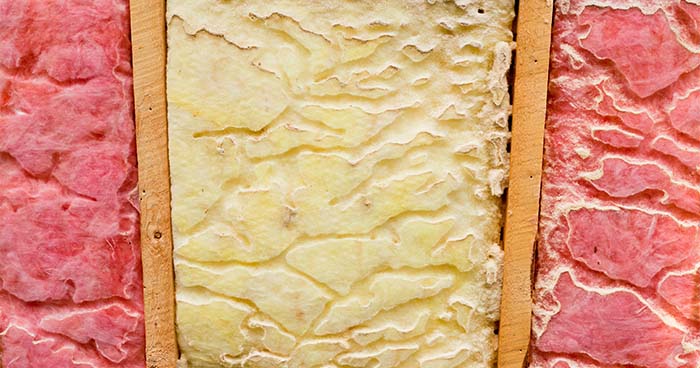When you turn on your heating, you want it to stay inside your home. Powering up the heating causes the heat to rise directly up into your attic. It’s then up to your attic insulation to do its job and block the heat from escaping.
Poor attic insulation is problematic for your home and your bank account. So, it’s obvious that you need to invest your time and money into insulating your home, but what attic insulators are out there for you to choose from? Which attic insulation is best? And what are the potential risks of each of them?
This article will outline the 4 types of attic insulation you can pick from, plus dive into the pros and cons of each. By the time you’ve finished reading this article, you’ll be able to make an educated decision that best suits your property, budget, and priorities.
1. Fiberglass Batt Insulation
The first and most common type of attic insulation is fiberglass batt insulation.
It looks remarkably like cotton-candy and clouds, and it’s likely the image you envision when someone says “attic insulation.” Its popularity has remained steady for decades, and it is a firm favorite amongst homeowners.
The glass fibers are then used in the form of batts. Batts are big, rolled up sheets of material which are fused together with a chemical vapor. This vapor acts as an adhesive.
The Advantages of Fiberglass Batt Insulation
Why is fiberglass batt insulation so popular? It’s many benefits include:
- As a whole, fiberglass is considerably eco-friendly. The fiberglass itself is created from sand which is then turned into glass, which counts as a renewable energy source.
- The vapor barrier is flame-proof and slows the spread of fires.
- Fiberglass batt insulation rarely shrinks or collapses. This is due to the air pockets that occur in production.
- Installation is straightforward. In fact, it’s so straightforward that many homeowners choose DIY installation. If you follow this route, you’d be dodging an installation fee.
- Fiberglass batt insulation is also soundproof, helping reduce external noises and keep internal sound inside the property.
The Disadvantages of Fiberglass Batt Insulation
While fiberglass batt insulation has many advantages, it also has its downsides:
- When you consider that fiberglass is, in fact, glass, it becomes apparent that there is a risk of injury.
- Further, the vapor that’s used as a barrier can be harmful if it’s touched or inhaled. Therefore, if you do choose this type of attic insulation, you should wear gloves and a mask for your safety.
- This type of insulation, like most, doesn’t mix well with moisture. Should it get wet, you’ll notice that it slacks on its job of keeping heat inside. Plus, it can take a very long time to dry out, if it ever does.
- If moisture is absorbed by the fiberglass batt insulation, it can breed dangerous mold.
- Rodents and other unwanted guests love fiberglass batt insulation, and often make it their home. As such, rodent infestations are a real possibility.
2. Blown-In Fiberglass Insulation
If you like the concept of fiberglass but aren’t keen on using batts, then blown-in fiberglass may be the way forward for you.
Blown-in fiberglass uses the same base material (fiberglass), but it doesn’t require the vapor. It differs based on the distribution method. Rather than being rolled up, it’s blown in through a blowing machine.

Some sources say that by making this small switch of distribution to blown-in, you can save up to 35 percent on your energy bills!
The Advantages of Blown-In Fiberglass Insulation
Blown-in fiberglass is a good choice for your attic insulation. But why? What are the benefits of blown-in fiberglass insulation?
- If energy efficiency is your priority, blown-in fiberglass ranks high.
- When using the blown-in method, it fills the attic better, ensuring it’s air-tight.
- As a result, it fills any cracks or gaps, even in awkward spaces. This reduces the amount of hot air escaping and cold air entering.
- It also traps sound.
- The blown-in distribution method is far quicker. It takes a matter of hours to get your attic insulation up and running. With fiberglass batt insulation, however, it often takes a few days.
- Using blown-in fiberglass insulation improves the air quality in your home due to not needing the vapor. This is particularly beneficial for households with members who suffer from allergies.
The Disadvantages of Blown-In Fiberglass Insulation
The advantages of blown-in fiberglass insulation are compelling. But what about the disadvantages?
- Whether in the form of batts or blown-in, fiberglass can be dangerous. It’s even sold with a health risk warning.
- After the insulation has settled, it’s proven that the R-Value decreases. It needs more maintenance than other types of attic insulation on our list.
- Should the insulation get damp, removing the insulation isn’t as easy as removing fiberglass batts. You’ll need to pick it all up, while wearing gloves, and remove it bit by bit.
3. Blown-In Cellulose
Next up on our list of attic insulation types is blown-in cellulose.
This attic insulation is also blown-in using a blowing machine, however the material used is different.
The material used here is cellulose. This is made from all different recycled material, including things made out of wood, newspapers, and cardboard. Then, boric acid and other substances are applied to flame-proof the attic insulation.
It’s then blown-in to fill the space and cover any gaps.
The Advantages of Blown-In Cellulose Insulation
Is blown-in cellulose insulation worth it? Here’s what it can offer your household:
- For the most part, blown-in cellulose is better for the planet. With cellulose being made from purely recycled material, there’s no need to produce new material. Reusing this is eco-friendly.
- The boric acid and other substances help to flame proof the insulation and slow the spread of fires.
- There’s a clear increase in the R-Value. Blown-in cellulose insulation has an R-Value that is 23 percent higher than fiberglass batts.
- Cellulose also helps reduce wind-washing.
The Disadvantages of Blown-In Cellulose Insulation
What are the cons of installing blown-in cellulose insulation in your attic? Here are the disadvantages:
- Cellulose is eco-friendly, however the further substances that are added are not. Boron is required to create boric acid, and the mining process that mines boron is harmful to the environment.
- The blown-in method is messy, which contrasts to the tidy batted approach.
- Cellulose also doesn’t mix well with liquid. Should it become damp, mold can grow quickly and spiral out of control. Rectifying this situation can be labor and time intensive, as you’ll need to pick up the insulation bit by bit, rather than in one roll.
4. Spray Foam Insulation
The final type of attic insulation is spray foam insulation. This is becoming more and more popular as time goes by, likely due to its extensive benefits.
Unlike all the other types of attic insulation, spray foam insulation is the only type to come as a liquid.
After being sprayed, it thickens and grows, and then sets as a durable foam. This foam slides neatly into any gaps, locking airtight, and cuts off any escape routes for your heating.
The Advantages of Spray Foam Insulation
Spray foam insulation is increasing in popularity. Here’s why:
- Unlike fiberglass which wilts over time, spray foam insulation is high-performing after settling, making it effective in both the short and long term.
- Spray foam has an impressive R-Value, falling between 5.6 and 8.0.
- The foam adds structural support to your home.
- Due to the foam filling any gaps remarkably well and the impressive R-Value, spray foam insulation is remarkably energy efficient.
- There’s no vapor barrier.
The Disadvantages of Spray Foam Insulation
Finally, what are the disadvantages of spray foam insulation?:
- The upfront payment for spray foam insulation is higher than the other types of attic insulation on our list. But, it’s worth considering that, due to high levels of energy efficiency, it’ll likely balance out or even become cheaper in the long-run to keep your home warm.
- If there are any gaps or holes after being installed, the spray foam can create or add to water damage.
- This water damage can be extortionate, making it an expensive fix (and an incredibly stressful experience).
- It’s for this reason that we highly recommend having a professional install your spray foam insulation, which adds installation fees to your final bill.
- The substances used to create the foam are dangerous to touch. If they come into contact with your skin, you could react with rashes, inflammation, and/or swelling. As such, great care needs to be taken around the foam, and you’ll need to wear goggles, a mask, and a respirator.
Whether you require installation, repair, or maintenance, our technicians will assist you with top-quality service at any time of the day or night. Take comfort in knowing your indoor air quality is the best it can be with MOE heating & cooling services Ontario's solution for heating, air conditioning, and ventilation that’s cooler than the rest.
Contact us to schedule a visit. Our qualified team of technicians, are always ready to help you and guide you for heating and cooling issues. Weather you want to replace an old furnace or install a brand new air conditioner, we are here to help you. Our main office is at Kitchener but we can service most of Ontario's cities
Source link






Add Comment